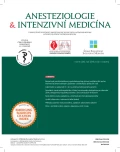Spontaneous rebound of the anticoagulant effect of accumulated dabigatran after the antagonist activity cessation: Case report of life-threatening haemorrhage
Authors:
J. Pažout 1; M. Mikešová 2; F. Duška 1
Authors‘ workplace:
Klinika anesteziologie a resuscitace, 3. lékařská fakulta Univerzity Karlovy a Fakultní nemocnice Královské Vinohrady
1; Laboratoř hematologie, Ústav laboratorní diagnostiky, Fakultní nemocnice Královské Vinohrady
2
Published in:
Anest. intenziv. Med., 29, 2018, č. 4, s. 201-206
Category:
Case Reports
Overview
NOAC (Non-Vitamin K Oral Anticoagulants) are currently increasingly used for treatment of thromboembolism. The main reason for their popularity is the possibility of oral application without the need to monitor their effect. In our report we describe the case of an 81-year-old man with paroxysmal atrial fibrillation treated with dabigatran, which accumulated in the patient, resulting in a life-threatening gastrointestinal bleeding. The patient was first treated with a prothrombin complex concentrate and then the selective dabigatran antagonist idarucizumab. An important finding from the case report was the existence of rebound phenomenon of returning anticoagulant activity of NOAC after application of idarucizumab due to accumulation of the dabigatran.
Keywords:
dabigatran – hemorrhage – idarucizumab − prothrombin complex concentrate − renal insufficiency
Sources
1. Loo SY, Dell'Aniello S, Huiart L, Renoux C. Trends in the prescription of novel oral anticoagulants in UK primary care. Br J Clin Pharmacol. 2017;83;2096–2106.
2. Bultas J. Nová perorální antikoagulancia – o čem se nemluví. Remedia. 2015;25:1127–1134.
3. Connolly SJ, Ezekowitz MD. Dabigatran versus warfarin in patients with atrial fibrillation. NEJM. 2009;361:1139–1151.
4. Rossaint R, Bouillon B, Cerny V, et al. The European guideline on management of major bleeding and coagulopathy following trauma: fourth edition. Critical Care. 2016;20:117.
5. Česko-slovenský mezioborový doporučený postup, „Diagnostika a léčba život ohrožujícího krvácení u dospělých pacientů v intenzivní a perioperační péči“. Anest intenziv Med. 2017;28:263–269.
6. Pollack CVJ, Reilly and van Ryn PA. Idarucizumab for dabigatran reversal—full cohort analysis. NEJM. 2017;377:431–441. http://doi.org/10.1056/NEJMoa1707278.
7. Česká společnost pro trombózu a hemostázu, „Postup při krvácení a perioperační management u nemocných léčených novými perorálními anticoagulancii (NOACs). [Online]. Available: https://www.csth.cz/soubory/csth-postup-pri-krvaceni.pdf. [Přístup získán 1. 2. 2018].
8. Tomaselli GF, Mahaffey KW. 2017 ACC Expert Consensus Decision Pathway on Management of Bleeding in Patients on Oral Anticoagulants. J Am Coll Cardiol. 2017; 70:3042–3067.
9. Ketha H, Mills JR. To Monitor Dabigatran or Not: A Matter of Patient Safety. Clinical Chemistry. 2015;61:691–693. http://doi.org/10.1373/clinchem.2014.232207.
10. Samuelson BT, Cuker A. Laboratory assessment of the anticoagulant activity of direct oral anticoagulants: a systematic review. CHEST. 2017;151:127–138. http://doi.org/10.1016/j.chest.2016.08.14.
Labels
Anaesthesiology, Resuscitation and Inten Intensive Care MedicineArticle was published in
Anaesthesiology and Intensive Care Medicine

2018 Issue 4
Most read in this issue
- Nová definice status epilepticus a možnosti jeho farmakologické léčby
- Patient transfers between healthcare facilities and referral healthcare facilities
- The use of ultrasound in interventional pain management
- Serum concentrations of calprotectin and cagranulin C in polytrauma patients
